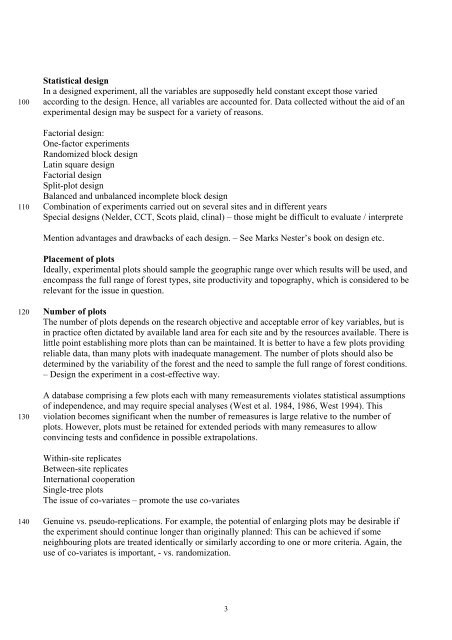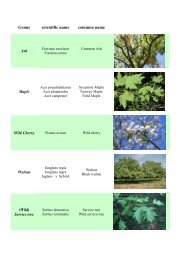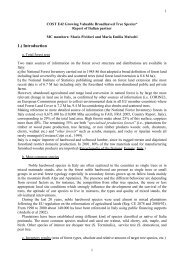Procedures for forest experiments and demonstration plots - Valbro
Procedures for forest experiments and demonstration plots - Valbro
Procedures for forest experiments and demonstration plots - Valbro
Create successful ePaper yourself
Turn your PDF publications into a flip-book with our unique Google optimized e-Paper software.
100<br />
110<br />
120<br />
130<br />
140<br />
Statistical design<br />
In a designed experiment, all the variables are supposedly held constant except those varied<br />
according to the design. Hence, all variables are accounted <strong>for</strong>. Data collected without the aid of an<br />
experimental design may be suspect <strong>for</strong> a variety of reasons.<br />
Factorial design:<br />
One-factor <strong>experiments</strong><br />
R<strong>and</strong>omized block design<br />
Latin square design<br />
Factorial design<br />
Split-plot design<br />
Balanced <strong>and</strong> unbalanced incomplete block design<br />
Combination of <strong>experiments</strong> carried out on several sites <strong>and</strong> in different years<br />
Special designs (Nelder, CCT, Scots plaid, clinal) – those might be difficult to evaluate / interprete<br />
Mention advantages <strong>and</strong> drawbacks of each design. – See Marks Nester’s book on design etc.<br />
Placement of <strong>plots</strong><br />
Ideally, experimental <strong>plots</strong> should sample the geographic range over which results will be used, <strong>and</strong><br />
encompass the full range of <strong>for</strong>est types, site productivity <strong>and</strong> topography, which is considered to be<br />
relevant <strong>for</strong> the issue in question.<br />
Number of <strong>plots</strong><br />
The number of <strong>plots</strong> depends on the research objective <strong>and</strong> acceptable error of key variables, but is<br />
in practice often dictated by available l<strong>and</strong> area <strong>for</strong> each site <strong>and</strong> by the resources available. There is<br />
little point establishing more <strong>plots</strong> than can be maintained. It is better to have a few <strong>plots</strong> providing<br />
reliable data, than many <strong>plots</strong> with inadequate management. The number of <strong>plots</strong> should also be<br />
determined by the variability of the <strong>for</strong>est <strong>and</strong> the need to sample the full range of <strong>for</strong>est conditions.<br />
– Design the experiment in a cost-effective way.<br />
A database comprising a few <strong>plots</strong> each with many remeasurements violates statistical assumptions<br />
of independence, <strong>and</strong> may require special analyses (West et al. 1984, 1986, West 1994). This<br />
violation becomes significant when the number of remeasures is large relative to the number of<br />
<strong>plots</strong>. However, <strong>plots</strong> must be retained <strong>for</strong> extended periods with many remeasures to allow<br />
convincing tests <strong>and</strong> confidence in possible extrapolations.<br />
Within-site replicates<br />
Between-site replicates<br />
International cooperation<br />
Single-tree <strong>plots</strong><br />
The issue of co-variates – promote the use co-variates<br />
Genuine vs. pseudo-replications. For example, the potential of enlarging <strong>plots</strong> may be desirable if<br />
the experiment should continue longer than originally planned: This can be achieved if some<br />
neighbouring <strong>plots</strong> are treated identically or similarly according to one or more criteria. Again, the<br />
use of co-variates is important, - vs. r<strong>and</strong>omization.<br />
3







